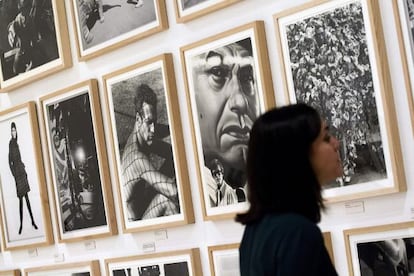Another side of a star
Works by Hollywood legend Dennis Hopper come to Málaga

As well as being the writer, director and star of Easy Rider, and a celebrated movie actor whose credits include Rebel Without A Cause, Blue Velvet and Speed, Dennis Hopper (1936-2010) was also a painter, art collector and photographer. In fact, "he wanted to be remembered most of all for his photographs," says his daughter Marin Hopper.
She was in Málaga this week to represent the foundation that bears her father's name, which has lent many of those photos - along with film clips, paintings and sculptures - for an exhibition at the city's Picasso Museum. "He started taking photos because he thought he wouldn't be able to direct a film," she explains. "He used images to see how he would frame a scene, and also to record the times."
Using a reflex camera that the first of his five wives gave to him as a present in 1961, Hopper devoted his efforts to immortalizing his environment - and the spirit of the times did the rest. The 141 black-and-white images on show in the exhibition feature, for instance, a painted elephant with the word "Love" written on it, and a clown hanging from the ceiling of his living room.
Hopper was one of the leading figures of a memorable age, starring in films such as Rebel Without a Cause
Also appearing in the photos are many of the big names of the era - from Paul Newman, Andy Warhol and Jane Fonda, to Martin Luther King, Allen Ginsberg and James Brown.
Hopper was one of the leading figures of a memorable age, starring in films such as Rebel Without a Cause (1955), Apocalypse Now (1979) and The Last Movie (1971). An almost prophetic film, the latter production was also a spectacular failure, one that took Hopper away from Hollywood and fame, to the extent that he is perhaps one of the lesser-known names among his illustrious gang of colleagues. His daughter attributes this to his "multidisciplinary talent" and because he was constantly passing "from one thing to another, and explored a lot." It also had a lot to do with drugs and alcohol, a fairly common hobby in 1960s' counterculture.
And this exhibition transports you to that world. Everything in the show - from the Harley Davidson parked by the first of Hopper's photos and the nine Pop Art works by artists such as Andy Warhol, Tom Wesselmann and Edward Ruscha, to the music of Tiny Turner and Jimi Hendrix - soaks you in that age of student protests, Woodstock and LSD, where man set foot on the Moon and imagined a better world.
Tu suscripción se está usando en otro dispositivo
¿Quieres añadir otro usuario a tu suscripción?
Si continúas leyendo en este dispositivo, no se podrá leer en el otro.
FlechaTu suscripción se está usando en otro dispositivo y solo puedes acceder a EL PAÍS desde un dispositivo a la vez.
Si quieres compartir tu cuenta, cambia tu suscripción a la modalidad Premium, así podrás añadir otro usuario. Cada uno accederá con su propia cuenta de email, lo que os permitirá personalizar vuestra experiencia en EL PAÍS.
¿Tienes una suscripción de empresa? Accede aquí para contratar más cuentas.
En el caso de no saber quién está usando tu cuenta, te recomendamos cambiar tu contraseña aquí.
Si decides continuar compartiendo tu cuenta, este mensaje se mostrará en tu dispositivo y en el de la otra persona que está usando tu cuenta de forma indefinida, afectando a tu experiencia de lectura. Puedes consultar aquí los términos y condiciones de la suscripción digital.
Últimas noticias
From digital curfews to blocking apps: How technology experts protect their children online
Why the price of coffee has skyrocketed: from Brazilian plantations to specialty coffee houses
Confined to a Cuban hospital: When electricity is a matter of life or death
The complicated life of Francesca Albanese: A rising figure in Italy but barred from every bank by Trump’s sanctions
Most viewed
- Why we lost the habit of sleeping in two segments and how that changed our sense of time
- Pablo Escobar’s hippos: A serious environmental problem, 40 years on
- Trump’s obsession with putting his name on everything is unprecedented in the United States
- The Florida Keys tourist paradise is besieged by immigration agents: ‘We’ve never seen anything like this’
- Charles Dubouloz, mountaineering star, retires at 36 with a farewell tour inspired by Walter Bonatti









































